In an earlier post I mentioned that I had been fortunate to have several German sources of information about Rosalie Schoenthal Heymann, her husband Willy, and their six children, three sons, Lionel, Walter, and Max, and three daughters, Johanna, Helene, and Hilda. I’ve already posted about the lives of the three sons. This post and the next will tell about the lives of the three daughters.
The death notice for one of those sons, Lionel, mentioned a sister named Henny Mosbach Rothschild; his full obituary mentioned an unnamed sister living in Sao Paulo, Brazil.
![Ancestry.com. Historical Newspapers, Birth, Marriage, & Death Announcements, 1851-2003 [database on-line].](https://brotmanblog.com/wp-content/uploads/2016/03/lionel-heymann-death-notice.jpg?w=584&h=300)
Ancestry.com. Historical Newspapers, Birth, Marriage, & Death Announcements, 1851-2003 [database on-line].
![Ancestry.com. Historical Newspapers, Birth, Marriage, & Death Announcements, 1851-2003 [database on-line].](https://brotmanblog.com/wp-content/uploads/2016/03/lionel-heymann-obit-clipped.jpg?w=584)
Ancestry.com. Historical Newspapers, Birth, Marriage, & Death Announcements, 1851-2003 [database on-line].
From the Steinheim site, I knew that the second-born child of Rosalie (Schoenthal) and Willy Heymann was their daughter Johanna; that site reported that Johanna was born in 1889, married someone named Mosbach, and died in Brazil. From the Juden in der Geschichte des Gelderlandes book, I learned that Johanna’s husband was Hermann Mosbach, a merchant in Ratingen, and that they had married on April 8, 1915.
Thus, I assumed that the sister mentioned in the obituary and the one named in the death notice were one and the same: Johanna (“Henny”) Schoenthal, who had married a man named Hermann Mosbach and who had ended up in Brazil. But I didn’t know anything about what had happened in between: Why had she gone to Brazil, not Chicago where her three brothers were living? When had she gotten there? What had happened to Hermann Mosbach? And who was the apparent second husband named Rothschild?
I did not find anything helpful on Ancestry, but on FamilySearch.org, I found two records from Brazil. The first was a record for a widow (“viuva”), Johanna Mosbach, born February 27, 1889, in Geldern, Germany, daughter of Willy Heymann and Rosalie Schoenthal. She was being admitted to Brazil as a permanent resident. The card was dated February 18, 1939, and indicated that she had arrived at the Porto de Santos on the ship Monte Sarmento.
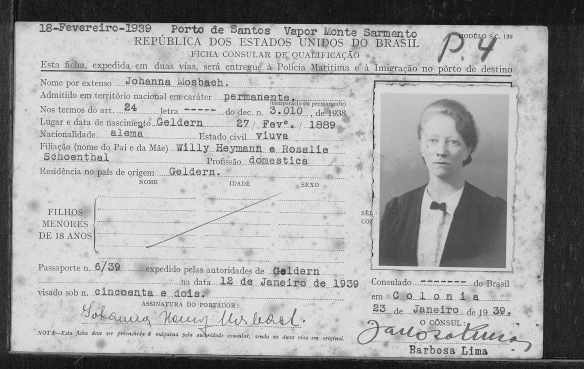
Brasil, São Paulo, Cartões de Imigração, 1902-1980,” database with images, FamilySearch (https://familysearch.org/ark:/61903/1:1:QKD5-RQ52 : accessed 31 March 2016), Joana Mosbach Rothschild, 1939; citing Immigration, São Paulo, São Paulo, Brazil, certificate 544986, registration 20634, Arquivo Público do Estado de São Paulo (São Paulo State Public Archives, São Paulo).
The second record I found for Johanna through FamilySearch’s Brazil database was not dated, but was presumably some years later. Her name is now recorded as Joana Mosbach Rothschild, same birth date as above, and she is now “casada” or married. She was apparently still an alien as this was a card issued by the public security secretary for registration of foreigners or “estrangeiros.”
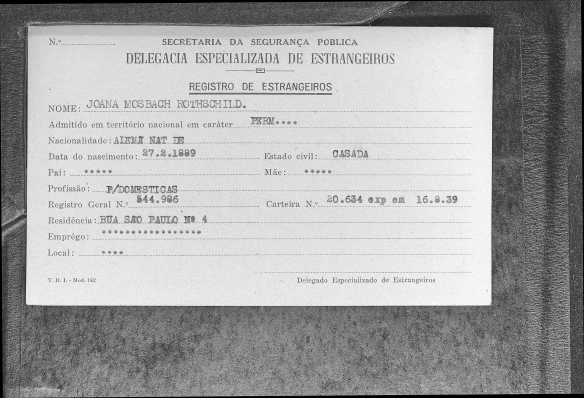
Brasil, São Paulo, Cartões de Imigração, 1902-1980,” database with images, FamilySearch (https://familysearch.org/ark:/61903/1:1:QKJG-XR67 : accessed 31 March 2016), Joana Mosbach, 1939; citing Immigration, São Paulo, São Paulo, Brazil, certificate 20634, registration 544986, Arquivo Público do Estado de São Paulo (São Paulo State Public Archives, São Paulo).
But that was as far as I could get without more assistance, so I sent an inquiry to a woman named Anita on the JewishGen Family Finder, who listed Mosbach as one of her family names. I also wrote to three of the JewishGen listservs, including one for Latin America. Once again, the genealogy village came through and provided me with helpful suggestions and ultimately many answers.
First, Anita from the JewishGen Family Finder sent me three links that provided more information about Johanna and her first husband Hermann Mosbach. All pertained to the Jewish community in Ratingen, Germany, before World War II. From these three sources, I learned that Johanna was Hermann Mosbach’s second wife and that he’d had a daughter named Else with his first wife. Hermann was born on July 18, 1877, and died on October 30, 1931, in Ratingen, when he was 54 years old. Here is a photograph of Hermann, standing far right.
(Caption under photograph says, “Hermann Mosbach, owner of the “Rheinische department store C. Schmidt & Co.”, was a member of the Catholic Mercantile Association (CISO). In the picture he is seen at an event of the club in the second row on the right. (1928).”
These sources also indicated that Hermann’s daughter Else had immigrated to Brazil in 1936 and that Johanna also had left Ratingen by 1936. Three years later she arrived in Brazil, presumably to be with her stepdaughter Else. That might explain why she did not go to Chicago to be with her brothers.
I was curious as to why Else and then Johanna would have selected Brazil as their new home. Was there a Jewish community there? Why Sao Paulo?
According to the Jewish Virtual Library, Sao Paulo had a long history of being a city that welcomed immigrants, receiving over three millions immigrants from all over the world before 1940. Jewish immigrants began to arrive in the late 19th century, but Jewish immigration really surged in the 1920s as immigration obstacles in the US and Canada made those less likely destinations for Jews leaving Europe. Sao Paulo, however, welcomed these immigrants, and during the 1920s, synagogues, Jewish schools, cemeteries, and other institutions were created to serve the growing Jewish population. After Hitler came to power in 1933, there was another large influx of Jewish immigrants to Sao Paulo. Thus, it made sense that Else Mosbach and her stepmother, Johanna Heymann Mosbach, would have settled there.
Neither Anita nor I could find any information about what happened to Johanna or her stepdaughter Else once they got to Brazil.
Fortunately, I then heard from Sandra through the LatinAmSig on JewishGen; she was born in Sao Paulo, Brazil; her family had also immigrated there to escape Nazi Germany. Sandra was incredibly generous and had asked her mother to see if she could find any information about Johanna or Else; she then sent me three links to additional online sources, including links to two newspaper articles regarding Else Mosbach Simon’s successful application to become a citizen of Brazil in 1950.
From those articles, I learned that Else was born on February 8, 1905, to Hermann and Selma Mosbach. Thus, Else had been only ten years old when Johanna married her father in 1915, further explaining why Johanna would have moved to Sao Paulo—to be closer to the child she had helped to raise. Else had married someone with the surname Simon by 1950, but unfortunately, I’ve not yet found out more information about her.
Sandra also gave me a link to the Arquivo Historico Judaico Brasileiro and suggested I contact the synagogues and Jewish cemeteries in Sao Paulo. She then translated into Portuguese an email I drafted and sent it to a person she knew at the synagogue when I had trouble trying to contact them directly through their website. From these sources, I learned that Johanna had died on September 11, 1971, and was buried at the Buntantan cemetery in Sao Paulo. She was 82 years old.
![By Dornicke (Own work) [CC BY 3.0 (http://creativecommons.org/licenses/by/3.0) or GFDL (http://www.gnu.org/copyleft/fdl.html)], via Wikimedia Commons](https://brotmanblog.com/wp-content/uploads/2016/03/sinagoga_beth_el_sc3a3o_paulo_1.jpg?w=584&h=438)
Synagogue Beth El in Sao Paulo By Dornicke (Own work) [CC BY 3.0 (http://creativecommons.org/licenses/by/3.0) or GFDL (http://www.gnu.org/copyleft/fdl.html)%5D, via Wikimedia Commons
The pieces were starting to come together, except that I still had no information about Johanna’s presumed second husband named Rothschild. Then someone sent me (I apologize for failing to note who that was) this marriage announcement in the September 29, 1957 issue of the O Estado de Sao Paulo (p. 12) for someone named Hans Joseph Schmitz, described as the son of Ferdinand Rothschild and Johanna Mosbach Rothschild:
Could this be my Johanna? Could she have remarried and had a son born sometime after 1939 who was now marrying—although he could be no more than 18 years old? That seemed unlikely, but now at least I had a first name to use for her presumed second husband.
I found a tree on Ancestry that included Ferdinand Rothschild and contacted the tree’s owner, Rainer. He informed me that Ferdinand Rothschild had married Johanna Heymann on April 9, 1955, when Johanna was already 66 years old and Ferdinand was 67. Ferdinand had been previously married to Grete or Gretchen Schmitz, Rainer’s great-aunt, who had died in Brazil on April 29, 1939. Hans was her son. He died on April 5, 1970, according to these death notices from the April 7, 1970, issue of O Estado de Sao Paulo, p. 35:
Rainer also sent me Ferdinand’s death record. He had died on December 31, 1958, while on a visit to Germany and was buried in Dusseldorf, Germany, not in Sao Paulo where Johanna was living. At the bottom of that record you can see a reference to the marriage date for Ferdinand and Johanna.
Johanna and Ferdinand had been married only three years when he died; he was seventy years old. Johanna would outlive her second husband by another thirteen years, dying, as noted above, on September 11, 1971, in Sao Paulo. Like her brothers Lionel and Walter, Johanna left no descendants behind, except for her stepdaughter Else Mosbach Simon and her stepson Hans Joseph Schmitz.
Once again, I am very grateful to all those who helped me put together these pieces of my cousin Johanna Heymann Mosbach Rothschild’s life, including my new cousins-by-marriage, Rainer and Anita, and especially Sandra, without whom I’d never have been able to learn where and when Johanna died and was buried.
That leaves me with the two remaining daughters of Rosalie Schoenthal and Willy Heymann: Helene and Hilda.

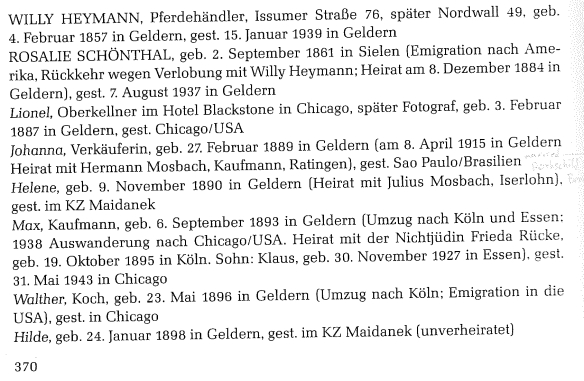
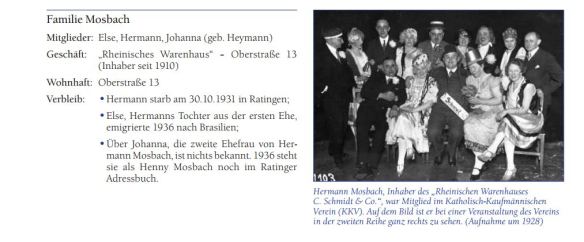

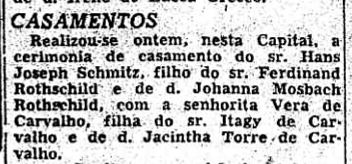


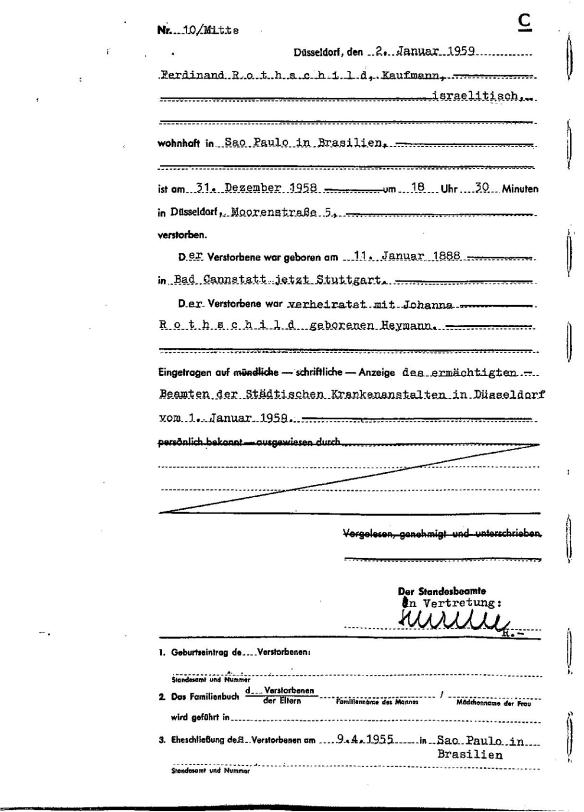
There are large Jewish communities in several South American countries. Uruguay allowed over 50,000 Jewish refugees in. It is the only country in South America with a holocaust memorial. In Argentina, another large Jewish community. It has a beautiful synagogue in Buenes Aires. Glad you discover a bit of the story of the refugees who survived due to South America.
LikeLiked by 1 person
One of the real surprise benefits of doing genealogy is how much I have learned about so many different places and times. Thanks, Ellen.
LikeLiked by 1 person
I was able to learn this over the years, have been in touch with emigrants in Uruguay, Argentina and Chile. Last year I went for a visit to meet some of my Jewish friends in all 3 countries – without a word of Spanish, including visits to synagogues etc.
LikeLiked by 3 people
I’ve never been to South America…so many places to see, so little time and money to do it!
LikeLiked by 1 person
Btw, according to a researcher, Uruguay took the largest number of Jewish refugees — in relation to the size of the population; many more than the USA!
LikeLiked by 2 people
Interesting!
LikeLike
I was there three years ago. There are still about 15,000 descendants of refugees and a thriving Jewish community. It was wonderful to see
LikeLiked by 2 people
I’m amazed at all the help you get from others. Kudos to Sandra!
LikeLiked by 1 person
I am also. And you are one of those helpers! 🙂
LikeLiked by 1 person
Thank you.
LikeLiked by 1 person
How wonderful that Johanna and Ferdinand had that special time together in their later years.
LikeLiked by 1 person
Very short, but I hope they were sweet years.
LikeLike
All I can say is WOW! The amount of information you were able to dig up is amazing!
LikeLike
Thanks, Debi. It took a LOT of luck and the help of others.
LikeLike
Such great finds with so much wonderful help! It seems Johanna was ready for her story to be told. I’m looking forward to hearing about her sisters.
LikeLiked by 1 person
Thank you—it is remarkable how helpful our fellow genealogy folks can be.
LikeLiked by 1 person
Amy, I very much enjoyed reading this post as I have ties to Brasil. I was an exchange student there many years ago, stayed with a wonderful family for the summer (1976) and I visited again (with my then 16 year old daughter) in 2006. We flew into Sao Paulo. And you are right about welcoming immigrants. Brasil is a vast country with many diversities, one of the aspects of that country I love most. They are very generous, giving people and Brasil is a wonderful place to visit. I may be able to help with your translations…falo pouquito Portugues, nao muito, mas entendou bastante. 🙂
LikeLiked by 1 person
Thank you, Karen, for these insights into Sao Paulo and Brasil. I’ve never been anywhere in South America unfortunately. And too bad I didn’t know before that you knew Portuguese!
LikeLike
Pingback: More Names to Remember and Never Forget | Brotmanblog: A Family Journey